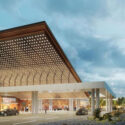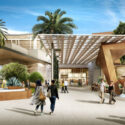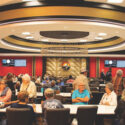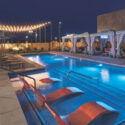
In the early 1950s, when Las Vegas had more sky than skyline, the pool at the Sands Hotel was considered an oasis in the desert. Vintage postcards show a classic kidney-shaped pool ringed by palm trees, with lounge chairs under striped umbrellas.
Guests could grab a snack or do a cannonball off the high dive, but otherwise, there wasn’t much to do at the pool. In the pre-air conditioning era, it was simply a place to cool off, slap on the Coppertone, and take a nap.
Compare that to Hakkasan Group’s Wet Republic, the day club and “Ultra Pool” at MGM Grand in Las Vegas. The 54,500-square-foot venue features 6,000 square feet of salt-water pools, dedicated valets, a sun deck that doubles as a dance floor, and king-sized beds that can accommodate up to 10 of your closest friends. Upgrade to the “VIP experience,” and you get your own bungalow with a flat-screen TV, oversized Jacuzzi and controllable misting system.
Nowadays, resort operators understand the value of the pool space. It has become a “Fantasy Island” for patrons, a critical component that often serves as a day club, a nightclub, a dance club and sometimes even a casino, all in one multi-purpose paradise.
Adult Swim
Some say the Big Pool Era originated with Rehab at the Hard Rock Las Vegas. When it debuted in 2003, as former Hard Rock President Kevin Kelley has said, the typical casino pool was “a slab of concrete with lounge chairs and 55-year-old cocktail waitresses slogging drinks.”
Rehab changed all that—and how. It opened with a splash, winning raves for its waterfall, water slides and real sand beach. Guests could loll in draped cabanas and on upholstered daybeds, and be served by bikini-clad cocktail servers. Celebrity DJs provided the soundtrack, and made Rehab the place to be for party-loving young adults.
The club’s success was a light-bulb moment, and helped turn the pool from an afterthought to a pivotal part of the destination.
“In a lot of ways, the pool is really the center of the experience,” says Andrew Kreft, executive senior principal and director of design for Lifescapes International, Inc., which has designed waterscapes for Encore Las Vegas, the Wynn and Red Rock Casino Resort, and is now working on Genting’s upcoming Resorts World Las Vegas. “It’s the heart of the resort—the dance floor of the club.”
For resort operators, it is also the gift that keeps on giving. A successful pool can keep patrons on property longer, generating revenues, buzz and a thousand online selfies, along with positive reviews and “likes” that make everyone else want to dive in.
“Properly used, it can be a revenue center with day passes in nearly all markets,” says Rich Emery, president of Thalden Boyd Emery Architects. “It’s a necessary draw for some non-gaming companions and spouses—the more reasons to stay longer, the better the incremental drop on the floor. A first-class pool is a requirement to a resort property.”
Stephen Ranck, project leader and principal with Gensler Architects, agrees. “As revenues continue to trend toward non-gaming components, a trend that started in Las Vegas in the early 2000s and is now over 60 percent, casinos are investigating a variety of entertainment, food and beverage,” and other non-gaming amenities like pools. “They bring a social connection to the casino experience”—a vital component for millennial customers, who number 80 million in the U.S. alone, with $200 billion in annual buying power, according to a January report in Forbes.
While pools like Rehab clearly target the millennial demographic, an artfully designed pool can attract patrons of many ages at different times, maximizing the value of the space.
“What makes a resort pool special is its appeal for a wide range of guests,” says Shannon McCallum Crawford, executive director of hotel operations for Aria Resort & Casino in Las Vegas. “We have the luxury in Las Vegas of having large pool spaces. At Aria, we’ve used that to our advantage by creating a number of smaller, more intimate environments—some that appeal to a high-energy crowd, some that appeal to those looking for a little more rest and relaxation.”
Day clubs tend to attract mostly millennials, Crawford says, “but our pool is a beautiful location for all types of special events: meetings and conventions, private soirees and weddings. Events after-hours are particularly inviting in the warm summer months, after the sun sets and the city lights up.”
High Water Mark
Resort guests tend to spend two to three days on average at the property, observes Kreft. The well-designed pool will offer activities that will grab and hold their interest for the duration.
Take the indoor Pool at Harrah’s Atlantic City. Reportedly modeled after Privilege, the world’s largest nightclub in Ibiza, Spain, it features a 90-foot-high glass dome and 82,000-gallon pool amid lush foliage. By day, it’s a sumptuous retreat where guests can lounge in private hot tubs and even order up a poolside massage. But at 10 p.m. every Wednesday, Friday and Saturday, it becomes the Pool after Dark, the city’s most popular nightclub, with a revolving cast of reality TV guests, and music by resident DJ Pauly D of Jersey Shore fame. In 2009, Harrah’s added the Loft, a $1 million upper-level gaming area where guests can play blackjack or roulette while looking out at the party.
“The Pool has three faces,” says Howard Weiss, regional vice president of nightlife operations for Caesars Entertainment’s Eastern Division. “It’s a resort pool seven days a week, a nightclub three nights a week, and a banquet facility on dark nights, where we cater to large companies and convention groups. If it’s January and there’s snow outside, you still feel like you’re on a tropical island. And the great part, from the resort perspective, is that it’s 82 degrees every day.”
Harrah’s Pool is inside due to the resort’s location in the Northeastern U.S. Indoor pools “should be considered in any weather condition,” says Bob Kelly, a senior vice president of Roy Anderson Construction. “The indoor/outdoor experience can be wildly successful when done correctly.”
Hnedak Bobo Group has designed a number of large-scaled, atrium-oriented resorts, “two of which have almost four acres under glass” and can accommodate pools, says principal Dike Bacon. “These environments are completely climate-controlled 365 days a year, and provide a multitude of opportunities to create outdoor experiences inside that are immune to climate changes. This is a very expensive proposition, however. The key to operational success of an atrium is to provide multiple revenue generation streams inside the space.”
Harrah’s Pool, for example, is adjacent to multiple venues targeted at millennials and non-gaming customers: a party pit outside the upscale Xhibition lounge; a high-end cocktail and craft beer outlet in the lobby; and new retail aimed at the 21-to-45-year old patron, says Weiss.
The Deep End
These days, as casinos evolve into “integrated resorts,” the emphasis is on “integr
ated.” Ideally, the pool is part of a “progressional” guest experience, interacting with other venues—restaurants, bars, shops, specialty gaming areas—like “pavilions in the garden,” says Kreft. The destination should be easily accessed, and the excitement teased as soon as a guest arrives on property. That goal can be harder to achieve when a pool is retrofitted onto an existing property.
“The big challenge is not getting brought in early enough to deal with the planning aspects. If you can come in earlier, you can plan the pool so it’s more physically integrated to the resort—not off on a strip of land, where you have to take a covered walkway and a shuttle bus to get there,” says Kreft. “It doesn’t necessarily need to be in the middle of the resort, but it should weave itself in both mentally and physically,” with landscaping and architectural elements serving as guideposts.
Separate points of entry and clusters of small and large gathering spaces make a pool area more multi-functional for “cocktail parties, wedding events or any kind of group,” he says. “You can cover the pool (perhaps using a translucent cover, lit from below) to gain extra square footage for events and turn it into a physical dance floor. That works especially well for smaller pool areas or hotels that don’t have a lot of space inside. A pool is an open canvas.”
Kreft strongly recommends real landscaping, plantings and trees wherever possible. “We never like to have anything artificial, exterior or interior, that you can touch and feel, unless you’re going for a unique abstract environment. Everything we do is theater; this is about setting the scene.” Moreover, he warns, artificial greenery doesn’t hold up over time, especially under continuous exposure to the sun. “It might look OK for a while, but may have to be replaced at some point; the cost saving over time is questionable.”
Pooling Resources
Patrick Murphy, president of Pechanga Development Corp., acknowledges that the Pechanga Band of Indians “sorely underestimated” the importance of a first-class pool when it opened its Temecula, California resort in 2002. “That’s why a proper resort-style pool complex features so prominently in our expansion plans,” he says. The Pechanga resort’s new pool complex “will span four acres and feature three pools and five hydrotherapy pools, including a family-friendly pool and a lagoon-style pool.”
Resort pools, especially the extravagant fantasy spaces expected by many patrons today, can be expensive and labor-intensive, says Paul Heretakis of Westar Architects. “But they can also attract thousands of people to a property in an afternoon. They must offer music environments, food and beverage. The up-charge of specialty seating and cabanas is very important. Some pool areas are large enough to have outdoor evening concerts, which are a great alternate use that commands a paid admission. This type of designed area can really become a very large cash revenue resource if it has the correct offerings and is run well.”
Overlooking the power of the pool “is a missed opportunity,” says Kreft. “These venues can be such greater moneymakers. And almost more importantly, they bring in an energy and electricity I don’t think you can get elsewhere. It is a congregation space. The challenge is recognizing how can you maximize and integrate it with any other offering you might have.”

















